 Churches of Christ & Christian Churches in the Pacific Northwest YAKIMA COUNTY, WASHINGTON |

Expanded Nov. 10, 2005 |
Cowiche | Selah | Wenas | Yakima | Zillah | Bird's Eye View
Montana page . . . Pioneer Menu . . Search - - Oldest presented first.

|
Flint had first come overland in 1845, arriving at Sutter's Fort in Sacramento. After a divorce, he moved to Polk County, Oregon; then he returned to Wisconsin and married Emeline Phinney. He returned to Oregon and settled in Douglas County. In 1869 he arrived in Yakima County and settled on Parker Bottom two miles northwest Buena where Flint Lane still exists. He had preached some prior to his divorce.
Ten years later, preacher Preston P. Underwood made the long ride from Fifteen Mile (Dufur) Oregon to the Yakima Valley and penned this report:
While there, in company with Bro. F(lint), I enjoyed the Christian hospitality of his daughter-in-law, Sister Purdy Flint, whose husband was absent on business.On Sunday, after witnessing the immersion of two sisters, I preached to an attentive audience, and then visited the beautiful home of Mr. Devinny, who has clearly shown that the sage brush land of Yakima valley is excellent garden and farming land. Of the abundance and fine qualities of his strawberries I had full proof both at the table and in the garden. The ground is so sloping that it is easily irrigated.
At five o'clock the Disciples met to break bread for the first time in that valley. At the conclusion of that impressive and solemn act, I addressed the congregation for an hour, seeking to build them up in their faith and to fortify them against the trying time of their warfare.
Bro. I. A. Flint has been preaching publicly and from house to house all over Yakima county for the last ten years, and has so labored that he thinks the time for a good ingathering is at hand. Owing to high water in the Natchey river which prevented many from attending, we did not organize.
It is one of the best openings that I have seen, and I hope to be able to make a cheering report from there before the season closes, for I expect to visit the valley again in a few weeks, and remain several days, endeavoring to so water what Bro. F. has planted, that a precious crop shall grow up unto the Lord.
A church building was built at Yakima City (now Union Gap) and dedicated in 1882. Historian Orval Peterson comments in detail about Isaac Flint:
It is said that Isaac Flint, the first pastor of the church in Yakima, lacked somewhat the virtue of patience. He lived in the little community of Donald, a few miles down the valley from the location of his church at Yakima, which is now Union Gap. If those who were to take him to church were late, he would not wait but would go afoot. He said, "I wait for no one." When he would arrive at the Yakima River, he would transport himself across by canoe and journey on to keep his preaching appointment.It is also said that he was a strong opponent of sectarianism and took frequent occasion to point out the sins of division in the church.. When the church building was erected in 1883, it was the first church building in the city and the second in the entire county. It is said that the shingles of the church were "rived and shaved" by hand and most of them by the hands of Isaac Flint, the minister. Lime for plaster was hauled in wagons from The Dalles. Laths were made on the same saw that cut the lumber and were all lengths from ten to twenty feet.

|
Dedicated in 1882, the little building traveled north in 1885. Courtesy of the Yakima Valley Genealogical Society |
The building was located "near Wide Hollow Creek north of the main part of Old Town which was closer to the south of Antanum Creek and near the first courthouse building in Yakima County."
As the Northern Pacific Railroad was being built, the rail yards were placed four miles north of Yakima City (renamed Union Gap) and the town was moved, free of charge, the four miles north. This included rolling the church building on logs to the new location in 1885. The move required three weeks. This may be where the congregation's motto "The Church on the Move" originated.
The building was placed in the middle of the block between Yakima Avenue and "A" Street on the east side of Third Street. About this time, a few feet were added to the building on the left side of the bell tower.
A panorama of Yakima shows the relocated building.
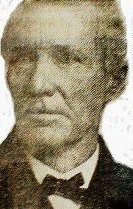
|
The next year, Jacob Eshelman of Goldendale was selected as the new minister. Mr. Eshelman was a Constitutional delegate from Yakima when Washington Territory became the State of Washington in 1889.
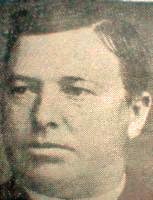
|
Courtesy of the Yakima Valley Genealogical Society |
The new building was dedicated in 1909 with a six weeks meeting held by Charles Reign Scoville. Six hundred were added to the church. This number is in keeping with Mr. Scoville's other meetings. He generally sent in an advance team of up to 14 people to teach the church to teach their friends. The team grounded the members carefully in Bible doctrines. When Scoville and his soloist wife Arlene arrived, people were planning on making the decision to be baptized into Christ.
Link for a biographical sketch of Charles Reign Scoville. Also see our entry under Albany First Christian Church.Wenas map
This pioneer farming community is 10 miles NW of Selah. Early crops were potatoes and alfalfa. Freight wagons and stage coaches traveled over Wenas Road on their way between The Dalles and Ellensburg.
Early Christians coming through included a large party of pioneers moving from Texas in 1883. They had all been members of the Christian Church on Bear Creek in Wise County, Texas. At least one family, the Mannings, decided to settle near Wenas while the rest moved on to Ellensburg. The story is in Tales of the Trail by Arabella Fulton.
The church met in a school house. The Year Book of the Disciples shows a congregation of 35 meeting here in 1893. A review of the names in the cemetery shows the connection to the Christian Churches. There are more than 40 names of Longmires. The Taylor families were related by marriage.
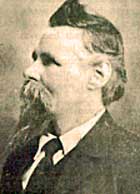
|
In his memoirs, pioneer wagon train leader and farmer-preacher James Longmire reports passing through the Wenas area on his way west. He later settled at Yelm, Washington.
Who was the church leader here? We think it was David Longmire, son of James. David was nine when the family wagon train passed this way. He returned here as a young man to develop the Wenas Valley. Beyond a doubt, he shared the faith of his preacher-father. One clue is that he was widely known as Uncle David, a term often applied to Church of Christ and Christian Church leaders in lieu of the "reverend" title used by others.
Zillah map
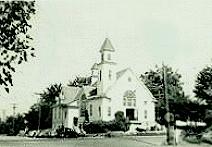
|
The first sermon preached in Zillah by a minister of the Christian church was delivered in January, 1895, by Freeman M. Walden, who owned a ranch near Zillah. The service was conducted in the old grade-school building. In February, 1900, Mr. Walden held a meeting which resulted in fifty-eight additions. The church was organized and the first church building erected that year. Mr. Walden continued to preach without pay until, on account of his age, he decided to quit farming and move to Seattle. In 1905 the parsonage was built. With the coming of the railroad through Zillah in 1909, the church buildings were found to be on the right of way. The railroad company moved the buildings to their present location. The present church building was dedicated on December 4, 1910, at the cost of about $12,000.The building pictured is probably the one remodeled after the move discussed by Mr. Petersen. It appears to be in an orchard area and the old building is seen at the rear of the picture.
Selah map
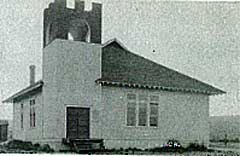
|
Copyright by Robert S. Lince |
An alternate view is that Selah came from an Indian word. Today Selah is the "Apple juice capital of the world."
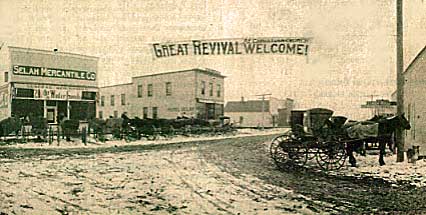
|
At Christian Church This was in 1909 Copyright by Robert S. Lince |
Arthur C. Vail had preached at Yakima First Christian Church in 1902. While there, he saw the need for a church in the community of Selah, just to the north of Yakima. That dream came to reality in 1908 when he launched Selah Christian Church.
An early fire map shows the building located at the S.E. corner of E. Fremont and N. Wenas Road.
While living in Selah, Mr. Vail purchased the local newspaper, The Selah Valley Optimist.
Cowiche map
There was a Christian Church or Church of Christ in Cowiche. The only clue is a one-line listing in a Yearbook of the Disciples of Christ.
The church met either in a home or a public building. It is certain that they did not build a church building. Public records reveal that members of the Christian Churches at Cowiche included Mr. and Mrs. Perry O'Neal and Mr. and Mrs. J. W. Tapp. In addition, members of the Strawn and Weedle families had moved to the valley from Linn County, Oregon. These families were strongly associated with the Restoration churches in Oregon.
Next Chapter: Montana page or back to Pioneer Menu

![]()